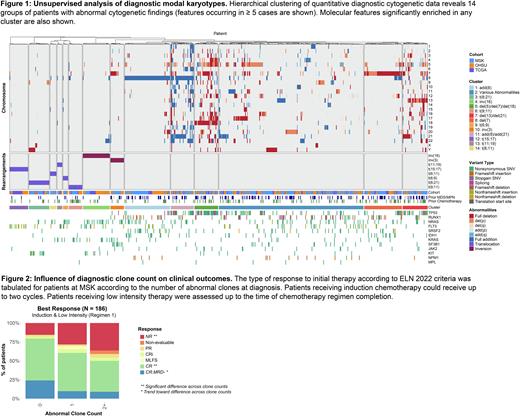Abstract
Introduction: Clinical risk assessment in AML relies on high quality cytogenetic data, often reported as a modal karyotype in International System for Human Cytogenomic Nomenclature format (ISCN). Here we show that quantitative assessment of clonal hierarchy is feasible for both internal and public datasets and reveals cytogenetic signatures reflective of disease biology both at diagnosis and relapse.
Methods We built karyoParser as an R package to facilitate automated analysis. Using the ISCN string, it builds a quantitative clonal hierarchy for downstream analysis including automated AML assessment using leukNLP (Abstract id: 170203).
To quantitatively assess relationships between different karyotypes, each alteration was assigned a value reflecting the degree of change. Translocations were assigned +3, full additions +1, full deletions -1, p arm additions +0.3, p arm deletions -0.3, q arm additions + 0.7, and q arm deletions -0.7. Hierarchical clustering was then performed on cases with cytogenetic abnormalities using Euclidean distance and Ward's method. Clusters were identified by cutting the dendrogram at a distance balancing intercluster homogeneity with intracluster heterogeneity. Cluster labels were assigned according to dominant cytogenetic features.
Clinical annotation of prior MDS cases at Memorial Sloan Kettering (MSK) were obtained through a manually curated database. MPN cases were identified using a composite of JAK2/CALR/MPL mutation presence as well as leukNLP annotation. Prior treatment information and AML therapy were also obtained through leukNLP annotation. Clinical annotation of TCGA and Beat AML cases were obtained from the respective publications. Enrichment for these features and molecular features in specific clusters was assessed using a logistic regression model.
The impact of diagnostic abnormal clone count was determined by Cox Proportional Hazards survival modeling. In the MSK cohort, response to therapy was obtained through leukNLP annotation and included complete response (CR), CR without minimal residual disease (CR MRD-), CR with incomplete count recovery (CRi), morphologic leukemia free state (MLFS), partial response (PR), and no response (NR). Patterns of clonal evolution were analyzed using a Cox Proportional Hazards event free survival model.
Results We applied karyoParser to a dataset consisting of AML patients from MSK (N= 599), the public TCGA AML cohort (N=195) 5 and public Beat AML cohort (N=466). Unsupervised analysis revealed 14 clusters, 8 of which were defined by well characterized AML translocations (Figure 1). Clusters 6 and 7 were enriched for prior chemotherapy (p<0.01, p<0.01). Clusters 2, 7, and 8 were associated with prior MDS or MPN (p<0.01, p< 0.01, p=0.01). Cluster 4 was negatively correlated with prior malignancy (p<0.01). Clusters 7, 5, and 11 were significantly enriched for TP53 mutations, exhibiting the diverse modalities of AML progression following this mutation (p < 0.01). We also note a significant enrichment of SF3B1 in the inv(3) cluster (p < 0.01) which was only recently described in AML. In addition, we note enrichment of KIT mutations in t(8;21) and FLT3-ITD in APL (p < 0.01, p = 0.04), which have been previously described.
We next sought to assess the impact of abnormal clones on clinical outcomes. In the combined cohort, increased abnormal clone count at diagnosis was associated with poorer overall survival (3 clones: HR: 3.2, p<0.01, 4+ clones: HR: 3.0, p <0.01). For the subset of patients at MSK with longitudinal data we found that depth of response was also influenced by abnormal clone count. Achievement of a CR decreased significantly with higher numbers of abnormal clones (p = 0.05) and NR increased (p < 0.01). CR MRD- also showed a trend toward decline with increasing abnormal clone count (p=0.10) (Figure 2). Time to relapse also differed based on the pattern of clonal evolution. Compared to normal karyotype cases, emergence of new clones had a significantly longer disease free interval (16.4 months; p=0.01) and relapse with an identical clone showed a trend toward a shorter interval (6.4 months; p=0.053).
Conclusion Quantitative assessment of hierarchically structured karyotypes in AML fills a void in the analysis of AML biology. Using karyoParser, we show that joint analysis of both public and local datasets is feasible in a way that defines novel disease biology, prognosis, and patterns of relapse.
Disclosures
Goldberg:AbbVie: Consultancy, Membership on an entity's Board of Directors or advisory committees, Research Funding; Astellas: Consultancy, Membership on an entity's Board of Directors or advisory committees; Genentech: Consultancy; Aprea, Aptose, AROG, Celularity, Pfizer, Prelude Therapeutics: Research Funding; Moderna, Novavax: Current equity holder in publicly-traded company; DAVA Oncology: Honoraria. Galera:PAIGE.AI: Research Funding. Elemento:Janssen: Research Funding; Johnson and Johnson: Research Funding; Volastra Therapeutics: Consultancy, Current equity holder in publicly-traded company, Research Funding; AstraZeneca: Research Funding; Eli Lilly: Research Funding; Freenome: Consultancy, Other: Current equity holder in a privately-held company; Owkin: Consultancy, Current equity holder in publicly-traded company; One Three Biotech: Consultancy, Current equity holder in publicly-traded company; Champions Oncology: Consultancy. Levine:Qiagen: Other: supervisory board member; Imago, Mission Bio, Bakx, Zentalis, Ajax, Auron, Prelude, C4 Therapeutics and Isoplexis: Current equity holder in publicly-traded company, Membership on an entity's Board of Directors or advisory committees; Ajax, Abbvie, Constellation, Zenalis, Celgene, Roche, and Prelude: Other: research support; Syndax, Incyte, Janssen, Astellas, Morphosys and Novartis: Consultancy; Astra Zeneca and Kura: Other: honoraria for invited lectures ; Gilead and Novartis: Other: Grant reviews.
Author notes
Asterisk with author names denotes non-ASH members.


This feature is available to Subscribers Only
Sign In or Create an Account Close Modal